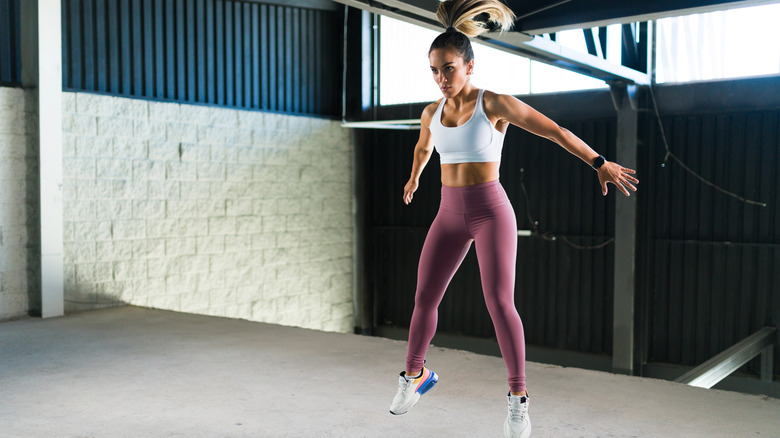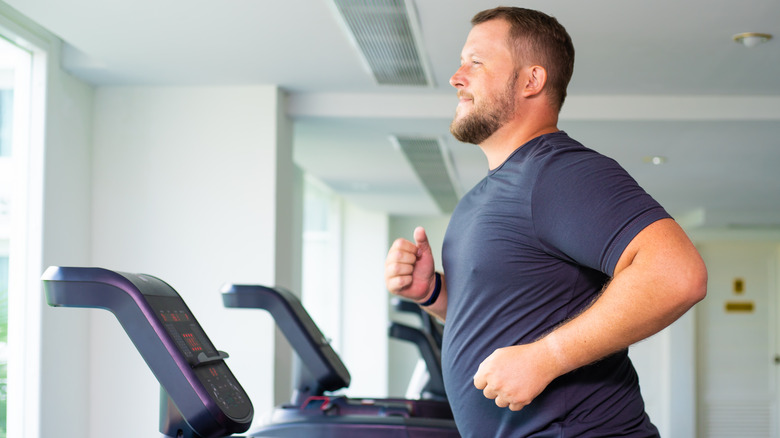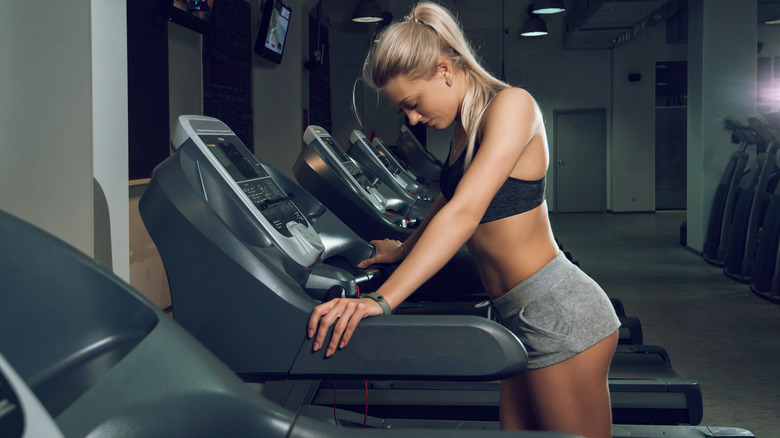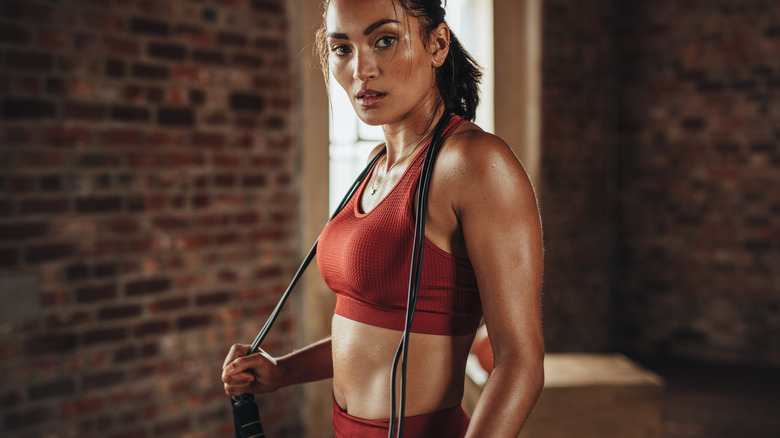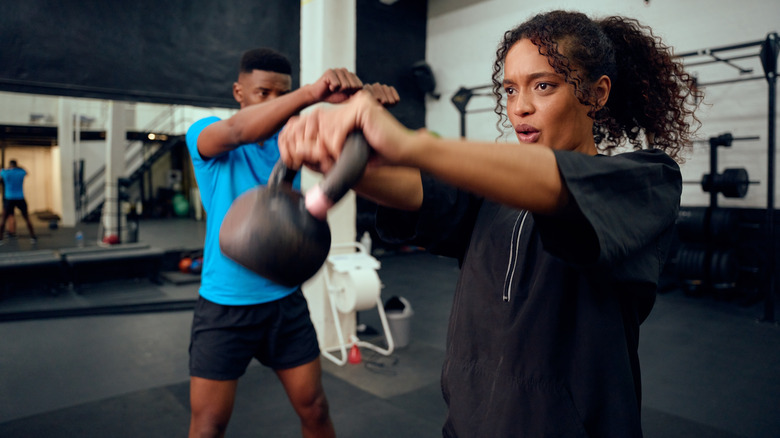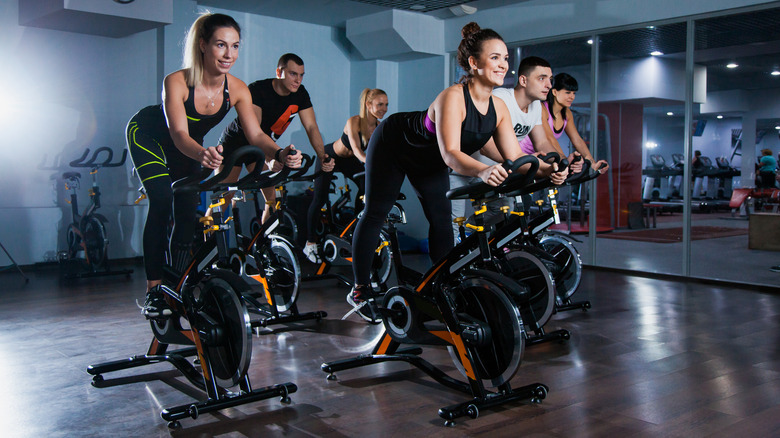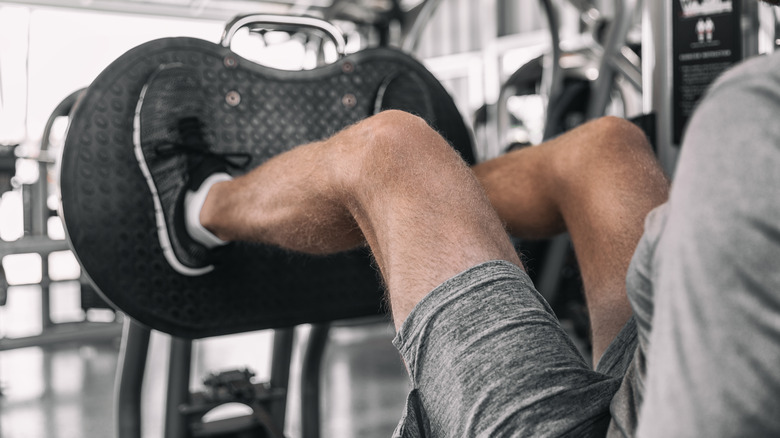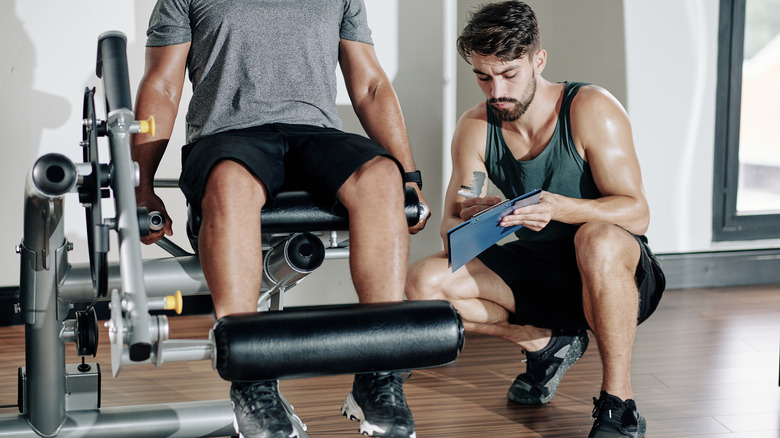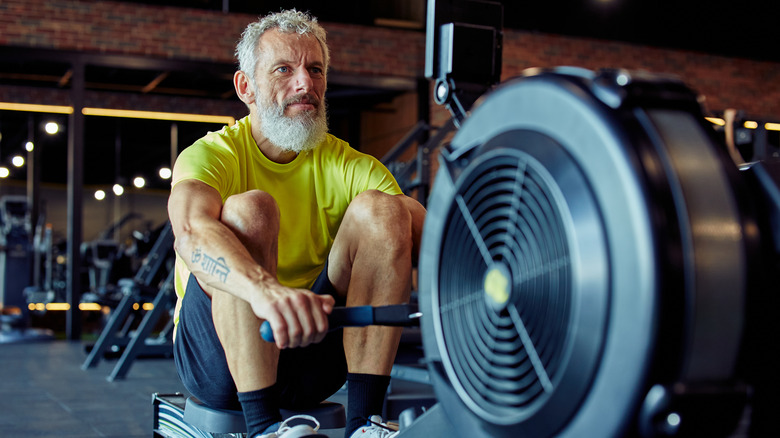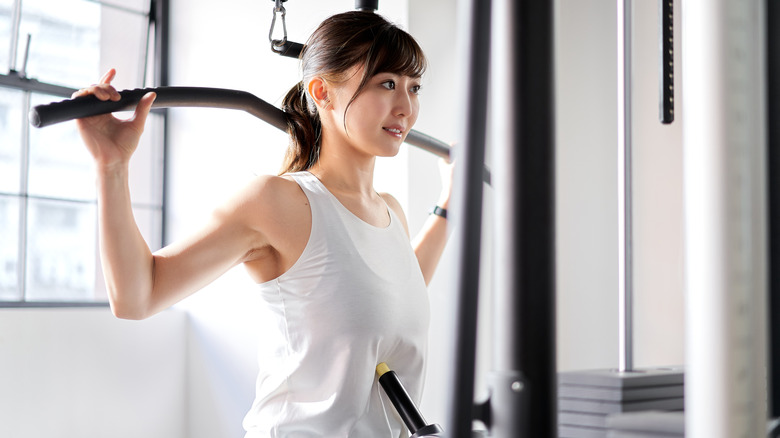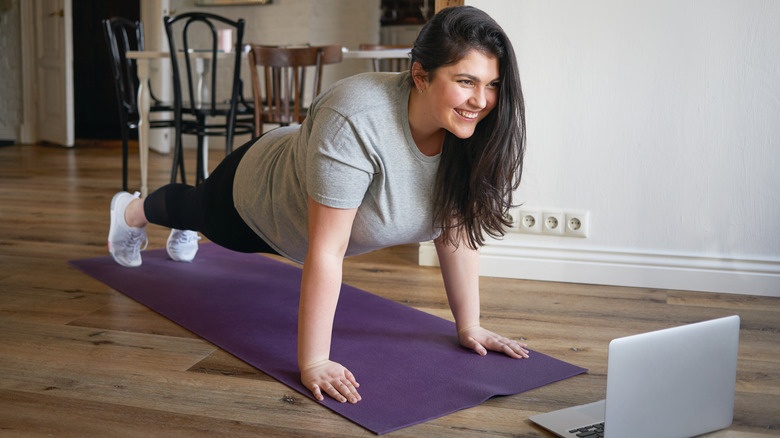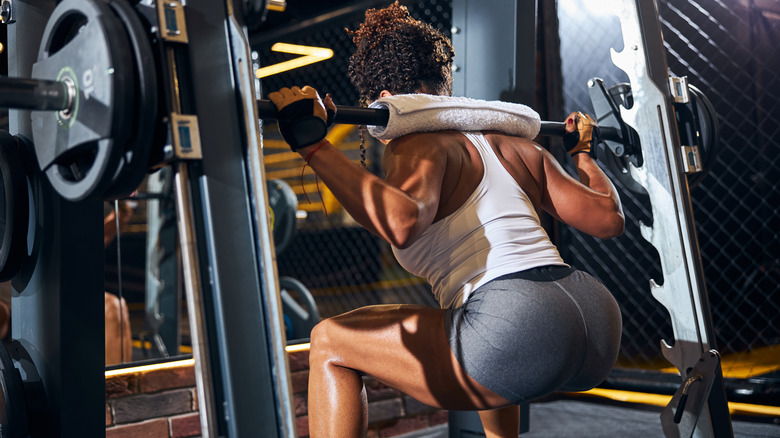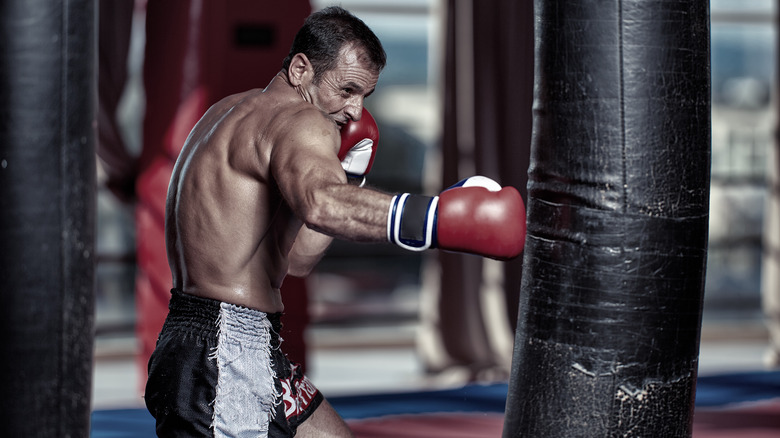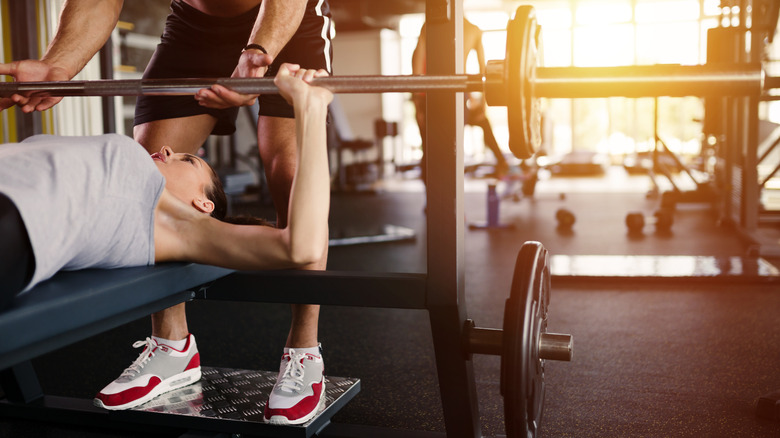Dangerous Mistakes You're Making With Exercise Equipment
For most of us, going to the gym is a way to stay active and in shape without putting ourselves in harm's way. We understand what adventure sports enthusiasts are into, and we are ultimately just trying to stay sane and fit without any adrenaline, thank you very much. Unfortunately, gym injuries can be surprisingly common, and many of them directly result from a user error. In fact, according to The Healthy, gym-related injuries have increased by a third in the recent past. We'd like to think that this is because more and more people are taking the initiative to pursue healthy lives, which deserves congratulating.
However, to avoid injuries, it is vital to understand some of the more common dangerous mistakes made with workout equipment. This is not your sign to reconfigure your New Year's plans to get in shape, to be clear — from slipped discs to crushed toes, performing exercises with poor form or using equipment in ways that it wasn't intended to be used is inherently dangerous. Gym protocols are set up the way they are to keep their members safe. If you are unsure about how to use a certain piece of workout equipment safely, it is best to ask a trainer or knowledgeable gym employee for tips. Here are some of the most commonly seen and dangerous mistakes people make with exercise equipment.
Jumping on and off a moving treadmill
Treadmills have a reputation for being one of the more dangerous pieces of equipment at the gym, which totally makes sense. After all, you are quite literally trying to tame a conveyer belt that is actively trying to fling you off the backside of it. The Healthy reports that 35% of gym-related emergency room visits are a direct result of treadmills and the use of them. One of the biggest no-no's when it comes to running on the treadmill is jumping off and onto the moving belt (via The Healthy). We get it — if you are a seasoned runner trying to hit your paces, you might feel empowered to hit a fast interval, jump to the stable sides of the machine, and then catch your breath as you slow the belt back to your base pace. But don't. In this case, the risk is much higher than the reward, so truly, it isn't worth it.
Instead, allow your body to dictate the speed that you can run safely at and use the transitional periods as a part of your workout. No matter your experience level, make sure to gradually increase the speed of your tread to stay safe. Familiarize yourself with the emergency stop button and speed dial to further ensure safety. If you are desperate to push your pace, do so at your local track to prevent accidentally catapulting yourself off of the treadmill. Your body and ego will thank you.
Leaning on the rails of your treadmill
Leaning on the treadmill's rails is another way to increase your risk of injury while working on your fitness. The postural implications of bending at the hips in such a way are significant, as are the potential negative consequences of bearing the load on the upper body during an activity that should engage your lower body muscles. The Healthy advises us to remember that the rails of the treadmill are absolutely not there to be used as if they are a handrail on the stairs; they should not be used as your lifeline while working out on a treadmill. The rails are, in fact, there for you to grab onto in case of an emergency.
If you find yourself relying heavily on the rails of the treadmill to support your workout, it is best to dial back the speed and potentially even the incline. By gradually easing into the appropriate pace and effort, you will be better able to reap the benefits of your efforts. By clinging onto the sides of the treadmill to propel yourself forward, you may actually be inhibiting the natural, and necessary, range of motion in your hips, as personal trainer Michael Moody told The Healthy.
Using an ill-sized jump rope
Jumping rope seems innocent enough, right? After all, it is a pastime that even young children can participate in. But hopping into a playground game of Double Dutch isn't quite as risky as attempting to finish 100 double-unders for speed at your local CrossFit gym. For one, speed ropes are usually the weapon of choice when it comes to fitness, and they feel more like a whip than a forgiving piece of cotton rope when they hit you.
Having the speed rope leave a burn on your ankles is not the only injury one can sustain while jumping rope. Overuse injuries such as shin splints and patellar tendonitis are fairly common in those who overuse their ropes (per Elevate Rope). As with most exercise equipment and routines, one of the best ways to decrease your likelihood of getting injured is just to start slow. If you go from doing no high-impact exercise to attempting to jump rope for an hour every day, you could be increasing your chances of developing an injury.
Since jumping rope is repetitive, there are a few other key safety elements that shouldn't be overlooked. Ensure that you are landing on your toes and not with a flat-footed, elephant-esque thud can help spare your joints. Additionally, skipping rope on an even and semi-forgiving surface, like a track, is a great way to minimize the joint load. Finally, measuring your jump rope to ensure it's the right size for your body is crucial to prevent physical compensations. To measure, stand on the rope and make sure that the handles reach your chest or shoulder height.
Swinging kettlebells too aggressively
If you are new to working out, kettlebells might seem like a daunting piece of exercise equipment. But we assure you, they aren't! And they are especially docile when used correctly. Much of the trouble with kettlebells comes from the momentum component of many exercises that utilize them, explains Jessica Jones, physical therapist and owner of Emerald Bay Physical Therapy, to Health Digest. When employed with proper form, swinging kettlebells can bring huge benefits. But when using them without anchoring yourself with stabilizing muscles, you are likely putting your joints and connective tissue in harm's way.
Jones explains that if your force is not being generated from your hips, in the case of kettlebells swings, you will likely end up straining your lower back, shoulders, and wrists. Relying on momentum alone increases your susceptibility of shoulder injuries, as the weight will likely encourage your shoulders to move beyond their comfortable range of motion. Also, your wrists are weaker than your shoulders in terms of the musculature that supports them. Trying to support too much weight on a small joint is akin to an elephant balancing on a tiny ball at the circus — it might look okay, but we all know that one wrong move could bring the entire thing tumbling down. To avoid an injury from swinging a too-heavy kettlebell too aggressively, it is best to start with lighter weights to ensure that you have a solid foundation before adding an additional challenge, Jones says.
Riding a spin bike that is improperly set up
Riding a bike is another activity that doesn't sound inherently harmful, mostly because many children ride bikes every day. But if you hit Soul Cycle with vigor every week, it is worth checking in to see if your bike is properly set up. If it isn't, you might be setting yourself up for injuries down the road. Generally speaking, none of us are truly symmetrical (via VeryWell Fit). We all have quirky muscular imbalances that can make or break each minor tweak of the saddle, so we truly have to listen to our bodies to maximize the fitness benefits of consistent cycling.
If your bike seat is too high, too far forward, or too far back, you are likely to start experiencing knee pain due to the incorrect alignment. If your seat is too low, it can contribute to hip flexor tension, which can affect the alignment of your spine and lead to neck pain. Over time, these issues can become chronic if not attended to as soon as symptoms start to flare up.
The rule of thumb for setting up your bike seat for indoor cycling is fairly simple, according to Jessica Jones, MPT: Set the saddle so it is even with your iliac crest (hip bone) when you are standing flat-footed on the ground next to your bike. Once you are on top of your bike, you'll want to move with smooth, even pedal strokes that generate strength. Your knees shouldn't feel like they are bending too deeply or like you are reaching out in front of you for the pedals. Engage your core by drawing your belly button toward your spine, soften your shoulders down away from your ears, keep a gentle bend in the elbows, and a soft pressure on the handlebars. No one is going to be able to catch you now!
Hyperextending your legs on the leg press machine
Hyperextending your joints is to be avoided in most circumstances. But when it comes to bearing load and locking out your joints, well, that is dangerous (via Healthline). At its root, hyperextension is the joint bending slightly in the direction it is not anatomically intended to bend. In the case of the knee joint, flexion is when you bend it and draw your heel back towards your buns; hyperextension is when the leg is extended at its full length, and the toes begin to reach toward the front side of your body with pressure on the knee joint. This pressure is what makes hyperextension so dangerous.
While bearing a load, your body is less likely to healthfully react to the pressure and more likely to absorb the pressure. This can result in pain and swelling in the joint capsule. If the weight and hyperextension are great enough, you may even risk the health of your ligaments. Tearing any one of the four ligaments major ligaments in your knee could require surgery to fix. To stay safe on the leg press and on all other load-bearing exercise machines, be mindful of only extending your joints to their natural open position. Pushing beyond that could leave you open to injury, and ain't nobody got time for that!
Relying on the knee extension machine
Your quads, the muscle group that makes up the front of your upper thigh, are a powerhouse. Your quads are likely firing nearly the entire time you're at the gym, especially if you engage in gross body movements such as squats, lunges, and more (via Verywell Health). Even just walking around the gym to get from machine to machine engages your quads to a lesser extent. However, there are not many options for isolating the quadriceps group (via Livestrong). Enter the knee extension machine. There is a time and a place to utilize this contraption for sure, but it does come with some risk.
For one, it locks your ankles in, which fully inhibits a lot of knee mobility. By then pressing up into the ankle pad, you put a lot of undue pressure on your ACL, which is one of the two ligaments that support your knee joint diagonally. The pressure is exceptionally high because, in this position, the stabilizing muscles of the hamstring group on the back side of your leg are removed from the equation. This locked-in movement can also encourage lateral patellar deviation, which essentially means that your kneecap is free to move about the cabin in ways that it should not. Finally, the real-world application of working your muscles in this way is lacking. If you choose to continue using the knee extension machine, do so in moderation and without maxing out the quad group.
Rounding your back on the rower
Oh, the rower. Yet another torture device machine that hard-core trainers seem to be obsessed with. They are obsessed for a good reason, just so you know. The rower is a great machine for engaging a ton of different muscle groups and for increasing your heart rate (via Women's Health). But going ham with poor form on the rower is likely to leave you injured, not with a body like The Rock. Most notably, it is important to remember that over half of the effort expended on a rower should be initiated through your legs (via Row Vigor). You will be doing yourself a major disservice if you force your upper body to do the bulk of the work.
Rounding your back as you row is another way to put yourself up for injury. Posture and form are pertinent no matter what exercise regimen you choose to follow, and the rower is no exception. Allowing your shoulders to round forward and the curvature of your spine to slacken puts unnecessary compression on the discs in your back. Sitting up straight throughout the entire range of motion is the best way to prevent unnatural stress on your spine.
Doing behind-your-head lat pulldowns
It is time to face the facts. The behind-your-head lat pulldown that your high school volleyball coach taught you just isn't right (via The Healthy). No shade to your misguided coach, but now that we know, we can stop doing this. We swear trainers cringe when they see people doing this at the gym, we swear. The entire purpose of the lat pulldown is in the name — it is supposed to target your latissimus dorsi, the gigantic bilateral muscle that plays a role in nearly every upper body movement. When you engage your core slightly, lean back, and draw the weighted bar to your chest, you engage your lats and other, smaller players in the upper body.
If you opt to sit up super tall and bring the weight down to the nape of your neck, you are way more likely to create weak links where injuries can surface. For example, drawing weight down in this manner puts unnecessary pressure on the rotator cuff and shoulder joint as a whole. Moreover, a behind-the-back lat pull down degrades the contraction of the lats, so you'll end up working harder but likely see fewer results.
Deadlifting with poor form
Executing a deadlift with poor form is incredibly dangerous when it comes to your lower back, as Jessica Jones, MPT told Health Digest. Conversely, performing a deadlift with good form is a great, dynamic way to build strength fairly quickly. While attempting to deadlift heavyweight, it is key to keep the core tight and the spine level. Slight rounding of the spine can encourage deactivation of the core, which can spell disaster for your lower back, according to Jones.
With improper form, the weight can wreak havoc on the muscle fibers and other connective tissues in the lower back (via Foothills Rehab). By over-extending certain muscles and failing to activate those you are endeavoring to work on, you increase your chances of developing strains and sprains. Taking the brunt of the effort through the lower back instead of the hamstring group can also leave you more open for disc injuries. As with many exercises, a deadlift is not inherently dangerous when performed correctly. When in doubt, start with less weight than you think you'll need and emphasize building the muscles that stabilize your core for success.
Letting your back sag during planks
Now, we realize that letting your back sag during planks is not something you are doing wrong with exercise equipment. But it is also very common to see people doing this in the gym, and over time, it can lead to postural imbalances and complications that can trickle into other movements that use other gym equipment. Planks are arguably one of the best exercises you can do, so it is super important to do them right (via Today). Besides, we all want to maximize our results, don't we? By dialing in your form, you'll be one huge step closer to reaching your goals.
Unfortunately, in a plank position it is all too easy to let gravity get the best of us and let our hips sag — it is easier after all. When our hips sag, it is often because we are not engaging everything properly. This puts us at risk of hyperextended joints, lower spine compression, and more. To stay safe and work out effectively in a plank, it is vital to engage your core by sucking in your tummy in toward your back. It's also important to energetically push out through your feet to engage your quads and other front-body muscles. Additionally, you should press into the palms of your hands to lift the chest and shoulders a bit to prevent further sagging (via The Healthy).
Rounding your spine at the squat rack
Squats are great, to be clear. They engage soooooo many muscle groups (via WebMD), build strength like crazy, and you can never really run out of variations to keep them interesting (via Healthline). But, like all other exercises and especially those that utilize equipment, it is super important to keep an eye on your form to prevent injury. Rounding your back at the squat rack essentially leaves the secondary and stabilizing muscle groups to support that heavy weight you've worked up to. This can leave you susceptible to strains, sprains, eventual disc bulges, and other injuries, as Jessica Jones, MPT explained to Health Digest.
Ensuring that you are drawing your belly button up and in toward your spine is a great place to start when it comes to finding the proper form for squatting. It is helpful to keep the chest and eyes slightly lifted to further prevent rounding of the spine. And when it comes to squats, do not be too prideful to ask for help from a trainer or film yourself on your phone to check in with your form. As with so many semi-dangerous exercises, remember to start loading slowly with intention on your form before loading your barbells up like you're the Hulk.
Hitting a heavy bag without experience
Boxing is a sport unlike most. You can truly build a ton of strength and increase your cardio work capacity by participating (via The Healthy). But just showing up to whomp on a heavy bag at your leisure isn't really the best way to go when it comes to getting fit. Walking straight up to a bag and releasing all of the anger and tension in your life through your fists is likely going to leave you with injuries. It is easy to forget that the force ripples throughout our bodies. Not only does hitting a heavy bag with poor form hurt our knuckles, but the force can impact the muscles in our necks, arms, upper bodies, and even cores. Beyond that, you need to wrap your hands, which takes practice, and ensure that the gloves you are wearing provide adequate protection. By ensuring that you are taking the proper precautions and following good form protocols, you are more likely to be safe during boxing practice.
Bench pressing too much weight
One of the most basic and avoidable pressing mistakes is neglecting to use a spotter (via Men's Health). Benching is especially dangerous because if the bar is too heavy, your arms could give out and the weight might end up landing directly on your chest or abdomen (via The Healthy). In less dramatic circumstances, it is still dangerous to fail a rep and then get trapped beneath the loaded barbell. The body position that you need to be in to execute a proper bench press leaves a lot of different body parts vulnerable to being crushed or tweaked under the pressure of the weight.
Even if you use a spotter, benching too much weight can be dangerous. If you are lacking proper form, your wrists might end up supporting more weight than they are capable of, which can lead to strains and sprains. Attempting to bench too much weight can also put unnecessary strain on the rotator cuff, leaving that susceptible to injury as well.

